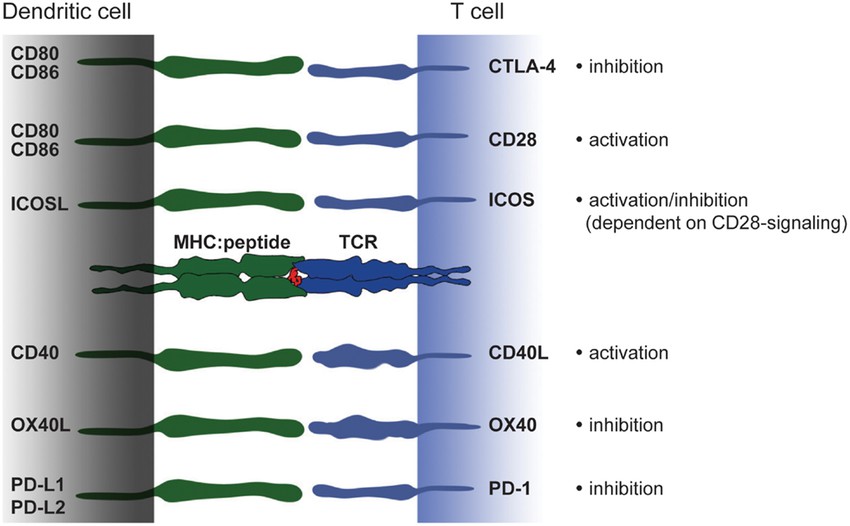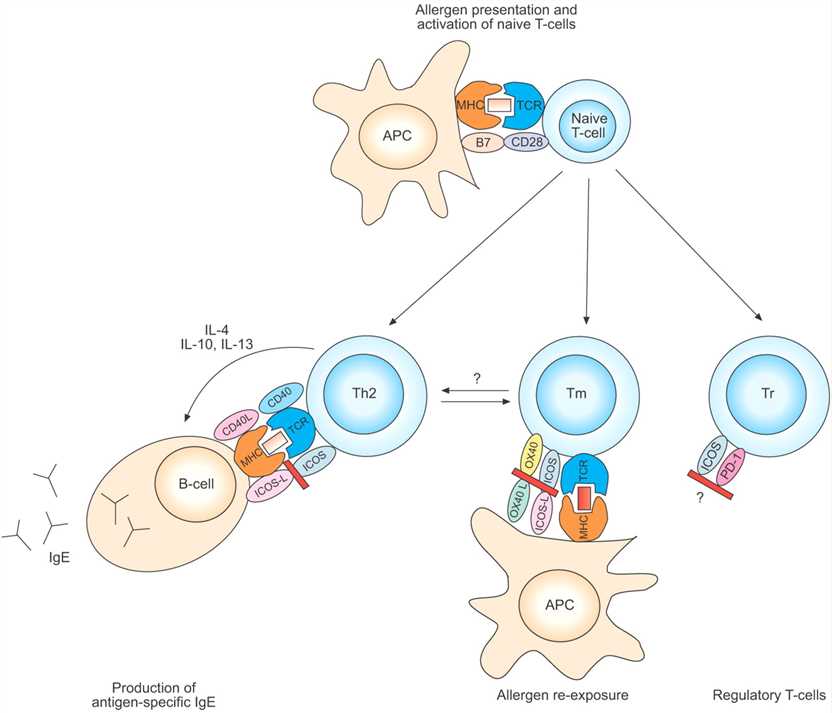Co-stimulatory Molecules
- LILRA3
- LILRA4
- SLAMF8
- CD58
- ITGA4
- CD2
- CD276
- CD28
- CD300A
- CD40
- CD80
- CD86
- Dectin-1
- Ctla4
- PD-L2
- SLAMF9
- TNFRSF9
- TNFSF9
- TNFSF9
- VTCN1
- LILRB1
- ILT4
- LILRB3
- SLAMF7
- BTLA
- CD160
- CD200
- CD244
- CD27
- CD274
- CD40 Ligand
- CD48
- CD7
- CD70
- CD84
- CD96
- CRTAM
- DPP4
- Havcr1
- HHLA2
- ICOS
- Icosl
- LAG3
- TNFB
- LY9
- NCR3LG1
- PDCD1
- PDCD6
- RELT
- SLAMF6
- Timd4
- TNFRSF13B
- TNFRSF13C
- HVEM
- Tnfrsf18
- TNFRSF1B
- TNFRSF25
- TNFRSF4
- TNFRSF8
- BAFF
- LIGHT
- TNFSF15
- TNFSF18
- Tnfsf4
- TNFSF8
About Co-stimulatory Molecules
Co-stimulatory molecules are essential components of the immune system that play a crucial role in regulating immune responses. These molecules are primarily found on the surface of immune cells and are involved in fine-tuning the activation and function of T cells, which are key players in adaptive immunity.
Co-stimulatory molecules work in conjunction with antigen-presenting cells (APCs), such as dendritic cells, macrophages, and B cells, to provide additional signals to T cells. These signals are necessary for the activation and differentiation of T cells, ensuring an appropriate immune response against pathogens while maintaining self-tolerance.
One of the most well-known and extensively studied co-stimulatory molecules is CD28. CD28 is expressed on the surface of T cells and interacts with its ligands, B7-1 (CD80) and B7-2 (CD86), which are expressed on APCs. The engagement of CD28 with B7 ligands provides a co-stimulatory signal that enhances T cell activation, proliferation, and cytokine production.
In addition to CD28 and its ligands, there are several other co-stimulatory molecules involved in immune regulation. Examples include:
CTLA-4 (Cytotoxic T-Lymphocyte Antigen 4): CTLA-4 is another receptor expressed on T cells that interacts with B7 ligands. However, unlike CD28, CTLA-4 delivers an inhibitory signal, dampening T-cell activation and suppressing immune responses. CTLA-4 plays a crucial role in maintaining immune homeostasis and preventing excessive immune reactions.
ICOS (Inducible T cell CO-Stimulator): ICOS is a co-stimulatory molecule expressed on activated T cells. It interacts with its ligand, ICOS-L, which is expressed in APCs. ICOS signaling enhances T cell proliferation, survival, and cytokine production, contributing to a robust immune response.
CD40 and CD40L: CD40 is expressed on APCs, while CD40L (CD154) is expressed on activated T cells. The interaction between CD40 and CD40L provides co-stimulatory signals that stimulate APC activation, antigen presentation, and cytokine production.
OX40 and OX40L: OX40 is expressed on activated T cells, while OX40L is expressed on APCs. The OX40-OX40L interaction promotes T cell survival, proliferation, and cytokine production, enhancing the generation of effector T cells.
These co-stimulatory molecules, along with others in the immune system, form a complex network of interactions that regulate the magnitude and quality of immune responses. Dysregulation of co-stimulatory signals can lead to immune dysfunction, autoimmune diseases, or inadequate immune responses against pathogens.
 Fig. 1 Costimulatory molecules and their ligands – a brief overview. (Hubo M, et al., 2013)
Fig. 1 Costimulatory molecules and their ligands – a brief overview. (Hubo M, et al., 2013)
Modulation of T cell activation is mediated by an interplay of different costimulatory molecules expressed on DC that have either immunogenic or tolerogenic function. The picture shows an overview of members from the B7 and TNF-receptor family expressed on DC and their binding partners on T cells. In the last decade a number of new costimulatory molecules have been identified. However, in the context of monocyte-derived DC CD80 and CD86 constitute powerful members of the costimulatory family. Strong CD80/CD86-derived signals can overcome e.g., ICOSL-mediated signaling and thereby turning a rather tolerogenic signal into an immunogenic.
Physiological Functions of Co-stimulatory Molecules
Co-stimulatory molecules play vital physiological functions in regulating immune responses and maintaining immune homeostasis. They provide additional signals that fine-tune the activation and function of immune cells, particularly T cells. Here are the physiological functions of co-stimulatory molecules:
T Cell Activation: Co-stimulatory molecules are essential for the full activation of T cells. When an antigen-presenting cell (APC) presents an antigen to a T cell through the major histocompatibility complex (MHC), the engagement of co-stimulatory molecules on the T cell with their ligands on the APC provides a second signal. This co-stimulation is necessary for the T cell to undergo clonal expansion, produce effector molecules, and carry out its immune functions effectively.
T Cell Differentiation: Co-stimulatory signals influence the differentiation of T cells into various subsets, such as helper T cells (Th1, Th2, Th17), regulatory T cells (Tregs), and cytotoxic T cells. Different co-stimulatory molecules and their interactions with T cells determine the direction and function of T cell differentiation, shaping the immune response to specific pathogens or antigens.
Immune Activation and Amplification: Co-stimulatory molecules enhance immune activation and amplify immune responses. By providing co-stimulatory signals, they promote the production of cytokines, such as interleukins and interferons, by T cells. These cytokines play critical roles in activating and recruiting other immune cells, expanding the immune response, and facilitating the elimination of pathogens.
Immune Tolerance and Regulation: Co-stimulatory molecules also contribute to immune tolerance and regulation. Certain co-stimulatory molecules, like CTLA-4 and regulatory T cell-associated co-stimulatory molecules, deliver inhibitory signals that restrain excessive or inappropriate immune responses. They help maintain immune homeostasis, prevent autoimmune reactions, and control immune-mediated tissue damage.
Antibody Production: Co-stimulatory signals are involved in the activation and differentiation of B cells, leading to antibody production. Co-stimulatory molecules on B cells interact with their ligands on T cells, providing signals necessary for B cell activation, proliferation, and differentiation into antibody-secreting plasma cells. This process is crucial for effective humoral immune responses.
Memory T Cell Formation: Co-stimulatory signals influence the generation and maintenance of memory T cells. Memory T cells are long-lived cells that provide rapid and enhanced immune responses upon re-exposure to a previously encountered antigen. Co-stimulatory molecules contribute to the differentiation of T cells into memory cells, ensuring the generation of immunological memory.
Understanding the physiological functions of co-stimulatory molecules is essential for the development of immunotherapies, vaccines, and treatments for immune-related diseases. Manipulating co-stimulatory signals can modulate immune responses, promoting protective responses against pathogens or suppressing inappropriate immune reactions in autoimmune or inflammatory conditions.
 Fig. 2 Blockade of co-stimulatory molecules in allergic airway inflammation. (Beier K C, et al., 2007)
Fig. 2 Blockade of co-stimulatory molecules in allergic airway inflammation. (Beier K C, et al., 2007)
Available Resources for Co-stimulatory Molecules
Creative BioMart is committed to aiding scientific researchers through an extensive array of products and tailor-made services related to co-stimulatory molecules. The products include recombinant proteins and others. We have meticulously gathered a wide range of resources on co-stimulatory molecules, covering involved pathways, protein functions, interacting proteins, pertinent articles, research areas, and associated subjects. Whether you are seeking insights into the regulatory mechanisms and pathways of co-stimulatory molecules or aiming to grasp their roles and functions in diverse biological processes, we are fully prepared to meet your needs.
Our Featured Products
- Active Recombinant Human CD28 Protein, Fc & Avi-tagged, Biotinylated
- Active Recombinant Human CD28 protein, hIgG-His-tagged
- Recombinant Human CD28 Protein
- Recombinant Human CD28, Fc tagged
- Recombinant Human CD28 Protein, Fc-tagged, Alexa Fluor 555 conjugated
- Recombinant Human CD28 Protein, Alexa Fluor 647 conjugated
- Recombinant Human CD28 Protein, Fc-tagged, Alexa Fluor 488 conjugated
- Recombinant Human CD28 Protein, FITC conjugated
- Recombinant Human CD28 Protein, Fc-tagged, FITC conjugated
- Recombinant Mouse Cd28 protein, His-tagged
- Recombinant Mouse CD28, Fc-His tagged
- Active Recombinant Human CD80, His-tagged, Biotinylated
- Active Recombinant Human CD80 protein, His-tagged
- Recombinant Human CD80, GST-tagged
- Recombinant Human CD80 Protein, Alexa Fluor 647 conjugated
- Recombinant Human CD80 Protein, His-tagged, Alexa Fluor 647 conjugated
- Recombinant Human CD80 Protein, Fc/His-tagged, Alexa Fluor 555 conjugated
- Recombinant Cynomolgus CD80 Protein, His-tagged, FITC conjugated
- Active Recombinant Human CD86 Protein, His & Avi-tagged, Biotinylated
- Active Recombinant Human CD86 Protein, Fc & Avi-tagged, Biotinylated
- Recombinant Human CD86 Protein, Fc/His-tagged, Alexa Fluor 488 conjugated
- Recombinant Human CD86 Protein, Fc/His-tagged, FITC conjugated
- Recombinant Rat Cd86 Protein, His-tagged, Alexa Fluor 488 conjugated
- Recombinant Cynomolgus/Rhesus macaque CD86 protein, His-tagged (HPLC-verified)
- Active Recombinant Human CTLA4 Protein, His-Tagged
- Recombinant Human CTLA4, Fc-His tagged
- Active Recombinant Human CTLA4 protein, mFc-Avi-tagged, Biotinylated
- Recombinant Human CTLA4 Protein, Fc/His-tagged, Alexa Fluor 488 conjugated
- Recombinant Mouse Ctla4 Protein, hFc-tagged, FITC conjugated
- Recombinant Rat Ctla4 Protein, His-tagged, Alexa Fluor 647 conjugated
- Recombinant Canine CTLA4 Protein, Fc-tagged, Alexa Fluor 555 conjugated
- Recombinant Human ICOS protein
- Recombinant Human ICOS Protein, Gly/Pro-tagged, Alexa Fluor 647 conjugated
- Recombinant Rat Icos Protein, Fc-tagged, Alexa Fluor 488 conjugated
- Recombinant Rat Icos Protein, Fc-tagged, Alexa Fluor 555 conjugated
- Active Recombinant Human CD40, Fc Chimera
- Active Recombinant Human CD40 Protein, Fc-tagged, FITC conjugated
- Active Recombinant Human CD40 protein, His-tagged
- Recombinant Human CD40 Protein, Fc/His-tagged, Alexa Fluor 555 conjugated
- Recombinant Human CD40 Protein, His-tagged, FITC conjugated
- Recombinant Mouse Cd40 Protein, Fc/His-tagged, Alexa Fluor 647 conjugated
- Active Recombinant Rabbit CD40 protein, His-tagged
Our wealth of resources and personalized services are brought together to propel co-stimulatory molecule research, enabling us to contribute to unraveling the complexities of these molecules and driving scientific advancement. Should you have any questions, specific requirements, or intentions for collaboration, please don't hesitate to reach out to us. We eagerly anticipate the opportunity to collaborate with you and assist in achieving your research and commercial goals.
References:
- Beier K C, Kallinich T, Hamelmann E. T-cell co-stimulatory molecules: novel targets for the treatment of allergic airway disease[J].European Respiratory Journal, 2007, 30(2):383.DOI:10.1183/09031936.00094406.
- Hubo M, Trinschek B, Kryczanowsky F,et al. Costimulatory Molecules on Immunogenic Versus Tolerogenic Human Dendritic Cells[J].Frontiers in Immunology, 2013, 4:82-.DOI:10.3389/fimmu.2013.00082.


